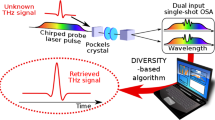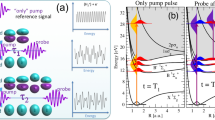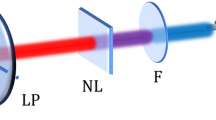Abstract
A key challenge in attosecond science is the temporal characterization of attosecond pulses that are essential for understanding the evolution of electronic wavefunctions in atoms, molecules and solids1,2,3,4,5,6,7. Current characterization methods, based on nonlinear light–matter interactions, are limited in terms of stability and waveform complexity. Here, we experimentally demonstrate a conceptually new linear and all-optical pulse characterization method, inspired by double-blind holography. Holography is realized by measuring the extreme ultraviolet (XUV) spectra of two unknown attosecond signals and their interference. Assuming a finite pulse duration constraint, we reconstruct the missing spectral phases and characterize the unknown signals in both isolated pulse and double pulse scenarios. This method can be implemented in a wide range of experimental realizations, enabling the study of complex electron dynamics via a single-shot and linear measurement.
This is a preview of subscription content, access via your institution
Access options
Access Nature and 54 other Nature Portfolio journals
Get Nature+, our best-value online-access subscription
$29.99 / 30 days
cancel any time
Subscribe to this journal
Receive 12 print issues and online access
$209.00 per year
only $17.42 per issue
Buy this article
- Purchase on Springer Link
- Instant access to full article PDF
Prices may be subject to local taxes which are calculated during checkout



Similar content being viewed by others
Data availability
The experimental data and computer code used in this paper are available from the corresponding authors upon reasonable request.
References
Paul, P. M. et al. Observation of a train of attosecond pulses from high harmonic generation. Science 292, 1689–1692 (2001).
Sansone, G. et al. Electron localization following attosecond molecular photoionization. Nature 465, 763–766 (2010).
Smirnova, O. et al. High harmonic interferometry of multi-electron dynamics in molecules. Nature 460, 972–977 (2009).
Diveki, Z. et al. Spectrally resolved multi-channel contributions to the harmonic emission in N2. New J. Phys. 14, 023062 (2012).
Calegari, F. et al. Ultrafast electron dynamics in phenylalanine initiated by attosecond pulses. Science 346, 336–339 (2014).
Nisoli, M., Decleva, P., Calegari, F., Palacios, A. & Martín, F. Attosecond electron dynamics in molecules. Chem. Rev. 117, 10760–10825 (2017).
Garg, M. et al. Multi-petahertz electronic metrology. Nature 538, 359–363 (2016).
Mairesse, Y. & Quéré, F. Frequency-resolved optical gating for complete reconstruction of attosecond bursts. Phys. Rev. A 71, 011401 (2005).
Sansone, G. et al. Isolated single-cycle attosecond pulses. Science 314, 443–446 (2006).
Mairesse, Y. et al. Attosecond synchronization of high-harmonic soft X-rays. Science 302, 1540–1543 (2003).
Tzallas, P., Charalambidis, D., Papadogiannis, N., Witte, K. & Tsakiris, G. D. Direct observation of attosecond light bunching. Nature 426, 267–271 (2003).
Nabekawa, Y. et al. Interferometric autocorrelation of an attosecond pulse train in the single-cycle regime. Phys. Rev. Lett. 97, 153904 (2006).
Kim, K. T. et al. Manipulation of quantum paths for space–time characterization of attosecond pulses. Nat. Phys. 9, 159–163 (2013).
Mairesse, Y. et al. High harmonic XUV spectral phase interferometry for direct electric-field reconstruction. Phys. Rev. Lett. 94, 173903 (2005).
Levesque, J. et al. Polarization state of high-order harmonic emission from aligned molecules. Phys. Rev. Lett. 99, 243001 (2007).
Camper, A. et al. High-harmonic phase spectroscopy using a binary diffractive optical element. Phys. Rev. A 89, 043843 (2014).
Bruck, Y. M. & Sodin, L. On the ambiguity of the image reconstruction problem. Opt. Commun. 30, 304–308 (1979).
Barakat, R. & Newsam, G. Necessary conditions for a unique solution to two-dimensional phase recovery. J. Math. Phys. 25, 3190–3193 (1984).
Klibanov, M. V., Sacks, P. E. & Tikhonravov, A. V. The phase retrieval problem. Inverse Probl. 11, 1 (1995).
Miao, J., Sayre, D. & Chapman, H. Phase retrieval from the magnitude of the Fourier transforms of nonperiodic objects. J. Opt. Soc. Am. A 15, 1662–1669 (1998).
Miao, J., Ishikawa, T., Anderson, E. H. & Hodgson, K. O. Phase retrieval of diffraction patterns from noncrystalline samples using the oversampling method. Phys. Rev. B 67, 174104 (2003).
Hayes, M., Lim, J. & Oppenheim, A. Signal reconstruction from phase or magnitude. IEEE Trans. Acoustics, Speech, and Signal Processing 28, 672–680 (1980).
Beinert, R. & Plonka, G. Ambiguities in one-dimensional discrete phase retrieval from Fourier magnitudes. J. Fourier Anal. Appl. 21, 1169–1198 (2015).
Raz, O. et al. Direct phase retrieval in double blind Fourier holography. Opt. Express 22, 24935–24950 (2014).
Leshem, B. et al. Direct single-shot phase retrieval from the diffraction pattern of separated objects. Nat. Commun. 7, 10820 (2016).
Raz, O. et al. Vectorial phase retrieval for linear characterization of attosecond pulses. Phys. Rev. Lett. 107, 133902 (2011).
Raz, O., Dudovich, N. & Nadler, B. Vectorial phase retrieval of 1-D signals. IEEE Trans. Signal Processing 61, 1632–1643 (2013).
Lucchini, M. et al. Ptychographic reconstruction of attosecond pulses. Opt. Express 23, 29502–29513 (2015).
Keathley, P. D., Bhardwaj, S., Moses, J., Laurent, G. & Krtner, F. X. Volkov transform generalized projection algorithm for attosecond pulse characterization. New J. Phys. 18, 073009 (2016).
Leshem, B., Raz, O., Jaffe, A. & Nadler, B. The discrete sign problem: uniqueness, recovery algorithms and phase retrieval applications. Appl. Comput. Harmon. Anal. 45, 463–485 (2018).
Acknowledgements
The authors thank Y. Mairesse for discussions and helpful comments. N.D. is the incumbent of the Robin Chemers Neustein professorial Chair, and gratefully acknowledges the Minerva Foundation, the Israeli Science Foundation, the European Research Council Starting Research Grant MIDAS, the Crown Photonics Center and the I-Core Center for financial support. F.C. acknowledges financial support from ERC Starting Research Grant STARLIGHT no. 637756. D.O. acknowledges financial support from the ICore program and the Crown Photonics Center. B.N. is the incumbent of the William Petschek Professorial Chair of Mathematics, and acknowledges financial support from the Israeli Science Foundation. O.R. is the incumbent of the Shlomo and Michla Tomarin career development chair, and is supported by a research grant from Mr and Mrs Dan Kane and the Abramson Family Center for Young Scientists.
Author information
Authors and Affiliations
Contributions
O.P., B.L., O.R., D.O., F.C. and N.D. conceived and designed the experiments. O.P., A.T., B.L., M.C.C., M.G., E.P.M., F.C., L.P. and F.F. performed the experiments. O.P., A.T., B.L., H.S., F.C., D.O. and N.D. analysed the data. O.P., A.T., H.S., M.L. and F.C. contributed materials/analysis tools. O.P., A.T., B.N., O.R., M.N., F.C., D.O. and N.D. co-wrote the paper.
Corresponding authors
Ethics declarations
Competing interests
The authors declare no competing interests.
Additional information
Publisher’s note: Springer Nature remains neutral with regard to jurisdictional claims in published maps and institutional affiliations.
Supplementary information
Supplementary Information
This file contains Supplementary Figures 1–8 and additional information about the work.
Rights and permissions
About this article
Cite this article
Pedatzur, O., Trabattoni, A., Leshem, B. et al. Double-blind holography of attosecond pulses. Nature Photon 13, 91–95 (2019). https://doi.org/10.1038/s41566-018-0308-z
Received:
Accepted:
Published:
Issue Date:
DOI: https://doi.org/10.1038/s41566-018-0308-z
This article is cited by
-
Α 10-gigawatt attosecond source for non-linear XUV optics and XUV-pump-XUV-probe studies
Scientific Reports (2020)



